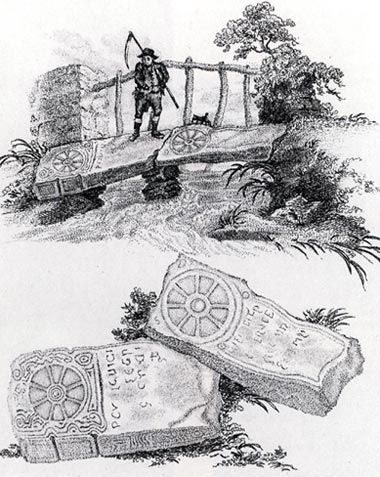A walk through south Wales in 1804
Amgueddfa Cymru holds an extensive collection of superbly illustrated topographical books dating from the late 18th and early 19th centuries.

11th century cross-slabs near Margam, from Donovan's Excursions (1805)
One such book, Descriptive Excursions through South Wales and Monmouthshire in the Year 1804, and the Four Preceding Summers, was written by the natural history writer Edward Donovan. A prolific author, his books cover various aspects of the animal kingdom including insects, shells and fish. They are characterized by a large number of coloured plates, many of a very high quality.
Donovan also made a large collection of natural history specimens, and it was this collection that was opened to the public in 1807 as the London Museum and Institute of Natural History. Although Donovan was originally a wealthy man, he died virtually penniless, as booksellers seem to have had control of all his writing, which was valued at over £60,000 in the 1830s.
Welsh parrots
In the two-volume Descriptive Excursions through South Wales and Monmouthshire in the Year 1804, and the Four Preceding Summers, which he published in 1805, he describes travels from Bristol to Pembrokeshire. Donovan makes a large number of comments on the natural history and geology encountered on his tours, such as the puffins at Caldey Island, which were known to seamen as 'Welsh parrots'.
Donovan's account covers the topography, local customs, architecture and antiquities of the places he visited. He acquired a Roman table-top from Caerleon depicting Venus, and included an illustration of this now lost piece of sculpture in his account of his tours.
The first volume takes the tour up to the Ewenny area near Bridgend, while the second volume takes the reader from Margam to Tenby. One chapter of over eighty pages describes the state of the remains and antiquities of Caerleon, not only a useful archaeological account in itself, but one that is accompanied by several engravings of finds from the Roman fortress, for example, sculpture, pottery, coins and tiles.
The Margam stone crosses
Antiquities of a later period are described in the second volume, when Donovan visited the Margam area. A feature of this area, besides the remains of the Cistercian abbey of Margam, was a number of inscribed stone crosses generally known as Early Christian monuments. A pair of these lay near the farmhouse of Cwrt-y-Dafydd.
The Cwrt-y-Dafydd crosses were then being used as a footbridge over a stream, depicted in one of the more charming plates used to illustrate the account of the tour, and Donovan describes them, making comparisons with similar monuments that he had seen at Llantwit Major. These cross-slabs now form part of the collection in Margam Abbey Museum, and are known from their inscriptions as the crosses of Ilquici and Ilci, and date to the 11th century.
Donovan went on to visit Margam itself, admitted to the grounds by the gardener who was 'allowed to admit strangers of respectable appearance', and describes and illustrates two further Early Christian monuments in the surrounding area.
These accounts offer a valuable insight of day-to-day life in Wales during the late 18th and early 19th century.